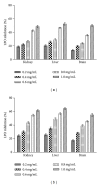In vitro antioxidant, antibacterial, and cytotoxic activity and in vivo effect of Syngonium podophyllum and Eichhornia crassipes leaf extracts on isoniazid induced oxidative stress and hepatic markers
- PMID: 25162013
- PMCID: PMC4137625
- DOI: 10.1155/2014/459452
In vitro antioxidant, antibacterial, and cytotoxic activity and in vivo effect of Syngonium podophyllum and Eichhornia crassipes leaf extracts on isoniazid induced oxidative stress and hepatic markers
Abstract
The present study reports the in vitro antioxidant, antibacterial, and cytotoxic potential of Syngonium podophyllum (SP) and Eichhornia crassipes (EC) leaf aqueous extracts as well as their in vivo effect on oxidative stress and hepatic biomarkers in isoniazid induced rats. Phytochemical screening of extracts revealed the presence of flavonoids, terpenoids, reducing sugars, alkaloids, and saponins. Phenolic content in SP and EC extracts was 5.36 ± 0.32 and 10.63 ± 0.13 mg PGE/g, respectively, while flavonoid content was 1.26 ± 0.03 and 0.51 ± 0.03 μg QE/mg, respectively. EC extract exhibited comparatively better antioxidant activity as indicated by reducing power (0.197-0.775), DPPH radical scavenging potential (11%-96%), and metal ion chelating ability (42%-93%). Both the extracts provided 13%-65% protection against lipid peroxidation in rat tissue (liver, kidney, and brain) homogenate. SP and EC extracts exhibited 51% and 43% cytotoxicity against lung cancer (NCI-H322) cell line, respectively. Both extracts demonstrated considerable antibacterial activity against Proteus vulgaris, Salmonella typhi, and Bordetella bronchiseptica. Coadministration of E. crassipes extract with isoniazid in rats accounted for 46% decrease in malondialdehyde content and 21% increase in FRAP value of plasma. It also mitigated the isoniazid induced alterations in serum enzymes (SGOT, SGPT, and ALP), total bilirubin, creatinine, and hemoglobin contents. S. podophyllum extract was found to be hepatotoxic.
Figures








Similar articles
-
Anti-staphylococcal properties of Eichhornia crassipes, Pistacia vera, and Ziziphus amole leaf extracts: Isolates from cattle and rabbits.Microb Pathog. 2017 Dec;113:181-189. doi: 10.1016/j.micpath.2017.10.015. Epub 2017 Oct 21. Microb Pathog. 2017. PMID: 29066382
-
Bauhinia variegata leaf extracts exhibit considerable antibacterial, antioxidant, and anticancer activities.Biomed Res Int. 2013;2013:915436. doi: 10.1155/2013/915436. Epub 2013 Sep 5. Biomed Res Int. 2013. PMID: 24093108 Free PMC article.
-
Total phenolic, total flavonoid content, and antioxidant capacity of the leaves of Meyna spinosa Roxb., an Indian medicinal plant.Chin J Nat Med. 2013 Mar;11(2):149-57. doi: 10.1016/S1875-5364(13)60042-4. Chin J Nat Med. 2013. PMID: 23787182
-
Antioxidant and Cytotoxic Effects of the Methanolic Extract of Eichhornia crassipes Petioles Upon Mg-63 Cell Lines: An In Vitro Study.Cureus. 2023 May 2;15(5):e38425. doi: 10.7759/cureus.38425. eCollection 2023 May. Cureus. 2023. PMID: 37273397 Free PMC article.
-
Phytochemical investigation, in vitro and in vivo antioxidant properties of aqueous and organic extracts of toxic plant: Atractylis gummifera L.J Ethnopharmacol. 2020 May 10;253:112640. doi: 10.1016/j.jep.2020.112640. Epub 2020 Feb 3. J Ethnopharmacol. 2020. PMID: 32027998 Review.
Cited by
-
Green synthesis of zinc oxide nanoparticles from Wodyetia bifurcata fruit peel extract: multifaceted potential in wound healing, antimicrobial, antioxidant, and anticancer applications.Front Pharmacol. 2024 Aug 5;15:1435222. doi: 10.3389/fphar.2024.1435222. eCollection 2024. Front Pharmacol. 2024. PMID: 39161893 Free PMC article.
-
Eichhornia crassipes (Mart.) Solms: A Comprehensive Review of Its Chemical Composition, Traditional Use, and Value-Added Products.Front Pharmacol. 2022 Mar 18;13:842511. doi: 10.3389/fphar.2022.842511. eCollection 2022. Front Pharmacol. 2022. PMID: 35370709 Free PMC article. Review.
-
In Vivo Delivery of Tinospora cordifolia Root Extract Preventing Radiation-Induced Dystrophies in Mice Ovaries.Evid Based Complement Alternat Med. 2015;2015:346427. doi: 10.1155/2015/346427. Epub 2015 Aug 18. Evid Based Complement Alternat Med. 2015. PMID: 26357520 Free PMC article.
-
Evaluation of anticancer activity of Cordia dichotoma leaves against a human prostate carcinoma cell line, PC3.J Tradit Complement Med. 2016 Dec 4;7(3):315-321. doi: 10.1016/j.jtcme.2016.11.002. eCollection 2017 Jul. J Tradit Complement Med. 2016. PMID: 28725626 Free PMC article.
-
Role of baicalin as a potential therapeutic agent in hepatobiliary and gastrointestinal disorders: A review.World J Gastroenterol. 2022 Jul 14;28(26):3047-3062. doi: 10.3748/wjg.v28.i26.3047. World J Gastroenterol. 2022. PMID: 36051349 Free PMC article. Review.
References
-
- Harman D. Role of free radicals in aging and disease. Annals of the New York Academy of Sciences. 1992;673:126–141. - PubMed
-
- Babu VLA, Gowri R. Evaluation of antioxidant activity of Beta vulgaris root extract in rats. Asian Journal of Chemistry. 2010;22(5):3385–3389.
-
- Janbaz KH, Gilani AH. Studies on preventive and curative effects of berberine on chemical-induced hepatotoxicity in rodents. Fitoterapia. 2000;71(1):25–33. - PubMed
Publication types
MeSH terms
Substances
LinkOut - more resources
Full Text Sources
Other Literature Sources
Medical
Miscellaneous

